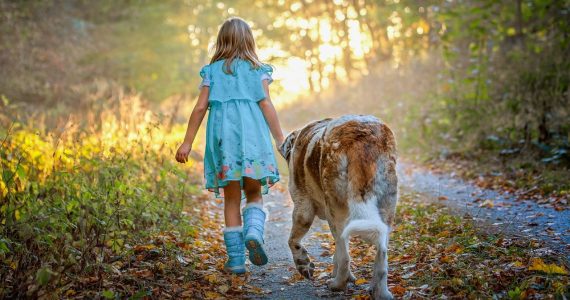Keeping Kids Safe around Dogs
Teaching Dog Safety for Children
Teaching children to be safe around dogs is an important part of being a pet parent
The following guide will help you teach dog safety for children and avoid your dog being placed in a compromising position.
For the most part, dogs are our lovable, goofy, tail-wagging companions and important family members. But each year, around 10,000 people attend the emergency department due to dog bites. Where children are involved, the trauma involved is much more serious.
There are over 3 million dogs in Australia, and there are only a small number that will ever bite a child. It is important to know that in the right circumstances even the most placid dog can snap. The common refrain when it does happen is ‘he’s never bitten anyone before’.
Rather than being a random event, 60 per cent of dog bites occur in the home or backyard of family, neighbours or friends. Even the most placid dog can bite and children under the age of 10 are at higher risk. Children under 4 years should never be left alone even with a family pet.
Dog body language
Sometimes we forget how easily we read dog body language without even thinking about it. This is a learned skill and children need to be helped to understand when a dog is not friendly.
For example, when dogs bare their teeth some children can interpret this as a smile. Teach your child what a relaxed and happy dog looks like and avoid any other dog.
A wagging tail can just meant the dog is keen to interact, but does not necessarily mean he is happy. In particular, an erect, upright, slow wag is a sign a dog is on high alert and should be approached with caution.
If a dog yawns, licks his lips or looks away, he does not want to be touched.
How to approach a dog
Children should be told to always ask permission before approaching a dog, particularly if that dog is tied up outside a shop.
They should never attempt to pat a dog who is eating, sleeping or has a toy.
Many dogs are ‘resource guarders’ and will bite if they feel they have to protect their possessions and territory, but are absolutely fine in most other situations.
A dog should be approached slowly with a closed hand, giving time for the dog to sniff the back of the hand. If all goes well, the dog can be gently patted on the chest or rubbed under the chin. Avoid the typical pat on the top of the head, as this can be a little daunting for some dogs.
Be a tree
Practice with your children the Be a Tree game.
When a child is approached by a strange dog they should stand still, arms by side, eyes cast downwards and stay absolutely still and silent.
You can practice this game at home with children by pretending to be a dog yourself and pretending to bound over to sniff your child. Many dogs will react if a child runs and shrieks, so practising how to stay calm and still as a game will help your child be safe.
Children and dogs as family pets
Many bites are from a trusted family pet. Little wonder, when children are their adorable but noisy and unpredictable selves.
They stare dogs directly in the face and are often at eye level and holding food, which can be very confrontational to your furry friend.
It is important to protect your dog from being in a situation where he feels that he needs to snap. He should feel that you have his back and that he does not need to protect himself or his resources.
Key points about dog safety for children
- Teach your children to ask you to get their toys back off your dog. Always give your dog another toy or treat in return when you take something from him.
- For pets over the age of 7 years, regular veterinary check-ups can ensure there are no health problems, such as pain, vision or hearing problems that might mean your pet is easily startled or grumpy.
- Banishing your dog to outside can have the effect that he feels isolated from the family. If you feel that your dog is not safe around children, seek the attention of a behaviour veterinarian who can help before problems develop.
- Place some strategic baby gates, so that if you need to leave the room your dog is not alone with the children.
- Gently touch your dog around the head, ears and tail and pair this with treats. Reward relaxed behaviour.
- Allow your children to give your dog treats.
- Take them all for walks together to make sure your dog feels a part of the family.
- Practice how to play ball with your family dog. Teach your dog to drop the ball on command and give a treat in return.
- When you first bring baby home, make sure all routine changes for your dog have occurred well beforehand. If your pet needs to sleep somewhere else, or will be spending more time outside, change this so that he doesn’t associate the baby with the changes.
Dogs are treasured members of our families and we want our children and dogs to be safe around each other and around other people’s families. Ensure you teach your children how to approach dogs safely, how to read dog body language and how to behave around their own pets.
Find out more useful tips for dog safety for children, including advice on interactions with children.
To discuss your dog safety concerns, contact our friendly team, or book an appointment online.

